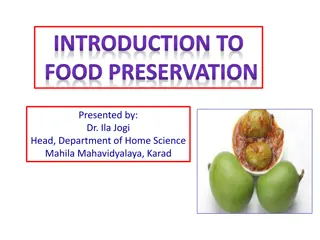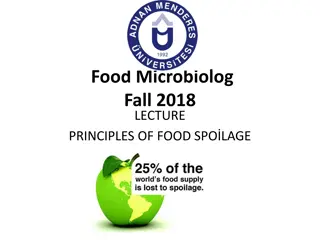Evolution of HACCP in Microbial Food Safety: A Comprehensive Overview
Explore the evolution of Hazard Analysis and Critical Control Points (HACCP) in ensuring microbial food safety, from its development in the 1960s for astronaut food to its mandatory regulations in the food industry. Discover key principles, challenges, and control measures associated with PR/HACCP implementation, and learn about the significant milestones leading to the current food safety standards.
Download Presentation

Please find below an Image/Link to download the presentation.
The content on the website is provided AS IS for your information and personal use only. It may not be sold, licensed, or shared on other websites without obtaining consent from the author.If you encounter any issues during the download, it is possible that the publisher has removed the file from their server.
You are allowed to download the files provided on this website for personal or commercial use, subject to the condition that they are used lawfully. All files are the property of their respective owners.
The content on the website is provided AS IS for your information and personal use only. It may not be sold, licensed, or shared on other websites without obtaining consent from the author.
E N D
Presentation Transcript
COMPLIMENTARY TEACHING MATERIALS MICROBIAL FOOD SAFETY A FOOD SYSTEMS APPROACH Charlene Wolf-Hall and William Nganje
Chapter 10: Control Measures: The Case of PR/HACCP COMPLIMENTARY TEACHING MATERIALS COMPLIMENTARY TEACHING MATERIALS
Key Questions What is HACCP and how has this food safety policy evolved? What are the principles of a HACCP plan? How was mandatory PR/HACCP policy formulated and implemented? What are the cost challenges with PR/HACCP and how were these reduced? Is continuous improvement possible with mandatory regulation? COMPLIMENTARY TEACHING MATERIALS COMPLIMENTARY TEACHING MATERIALS
Background on PR/HACCP The concept of HACCP was developed in the 1960s through a collaboration between the Pillsbury Company, the United States Army Laboratories and the United States National Aeronautics and Space Administration (NASA), where foods for astronauts being developed needed to be as safe as possible (imagine having a foodborne illness in space). COMPLIMENTARY TEACHING MATERIALS COMPLIMENTARY TEACHING MATERIALS
Timeline for the Final PR/HACCP Rule 1970s HACCP principles were being voluntarily implemented by firms that produced low-acid canned foods. 1995 The Food and Drug Administration (FDA) issued HACCP regulations for fish and seafood. 1998 The United States Department of Agriculture s Food Safety and Inspection Service (USDA-FSIS) mandated HACCP for raw meat and poultry plants. COMPLIMENTARY TEACHING MATERIALS COMPLIMENTARY TEACHING MATERIALS
2001 - The Food and Drug Administration issued HACCP regulations for juice processing and packaging. Other pilot and voluntary initiatives started in the dairy and other sectors. 2010 The Food Safety Modernization Act will result in more mandatory HACCP-like programs under the FDA and USDA-FSIS. COMPLIMENTARY TEACHING MATERIALS COMPLIMENTARY TEACHING MATERIALS
Three Major Components 1. A requirement for sanitation standard operating procedure (sanitation SOP s); Development of a HACCP Plan with critical control points and critical limits; Microbiological performance criteria and standard, with a major emphasis on Salmonella reduction and the use of E. coli testing for process verification. 2. 3. COMPLIMENTARY TEACHING MATERIALS COMPLIMENTARY TEACHING MATERIALS
HACCP Principles and Design HACCP implementation is based on a good understanding of the seven HACCP principles. Five preliminary steps should be completed before outlining the seven principles of HACCP. COMPLIMENTARY TEACHING MATERIALS COMPLIMENTARY TEACHING MATERIALS
Five Preliminary Steps 1. Develop a HACCP team; 2. Describe the food and its method of distribution; 3. Identify the intended use and target consumers; 4. Develop a flow diagram which describe the process; 5. Verify the flow diagram. COMPLIMENTARY TEACHING MATERIALS COMPLIMENTARY TEACHING MATERIALS
HACCP Principles 1. Conduct a Hazard analysis. 2. Identify the critical control points (CCP). 3. Establish critical limits for each CCP. 4. Establish procedures to monitor CCPs. 5. Establish corrective actions when CCP limits are exceeded. 6. Establish verification procedures. 7. Record keeping. COMPLIMENTARY TEACHING MATERIALS COMPLIMENTARY TEACHING MATERIALS
PR/HACCP Policy Formulation and Implementation FSIS outline eight policy formulation and implementation procedures. 1. 2. 3. FSIS regulatory and inspection reform plan for PR/HACCP. Changes within FSIS. Coordination between food safety agencies to incorporate farm-to-table strategy. Establishing firm-level performance standard. FSIS verification. Process control verification. Enforcement and due process. FSIS enforcement strategy. Reassessment. 4. 5. 6. 7. 8. 9. COMPLIMENTARY TEACHING MATERIALS COMPLIMENTARY TEACHING MATERIALS
Implementation Issues for Small Firms The FSIS recognizes that many smaller establishments lack the familiarity with HACCP that existed in many larger establishments. FSIS developed 13 generic HACCP models for the major process categories. The generic models were developed specifically to assist small and very small establishments in preparing their HACCP plans. COMPLIMENTARY TEACHING MATERIALS COMPLIMENTARY TEACHING MATERIALS
Comparison of Cost Regulatory component I. Sanitation SOPs II. Time temperature requirements III. Antimicrobial treatments IV. Micro testing V. Compliance with Salmonella standards VI. Compliance with generic E. coli criteria HACCP Plan development Annual plan reassessment Proposal 175.9a 45.5 51.7 1,396.3b Final 171.9 0.0 0.0 174.1 Not separately estimatedc 55.5 243.5 Not applicable Not separately estimated 35.7 0.0 54.8 8.9 Record keeping (recording, reviewing and storing data) Initial training Recurring training VII. Additional overtime Subtotal industry costs VIII. FSIS costs Total Source: Federal Register, Vol. 61, No. 144. a The preliminary analysis included a higher cost estimate for sanitation SOPs ($267.8 million) that resulted because of a programming error. The cost estimate of $175.9 million is based on an effective date of 90 days after publication. b The preliminary analysis was based on the premise that microbial testing would be expanded to cover all meat and poultry processing after the HACCP implementation. The proposed rule only required sampling for carcasses and raw ground product. Thus, the cost estimate of $1,396.3 million was higher than the actual cost of the proposed sampling requirements. c The preliminary analysis accounted for some of the cost of complying with the new standards under the regulatory components of micro testing, antimicrobial treatments and time and temperature requirements. d These costs are slightly different from the proposal because of changes in the implementation schedule. e FSIS added the cost for recurring training based on the review of public comments. f Based on current estimates for the cost of training, inspector upgrades and $0.5 million for annual HACCP verification testing. 456.4 440.5d 24.2 0.0 20.9 2,206.6 28.6f 2,235.2 22.7d 22.1e 17.5d 968.0 1,156.0 56.5 1,024.5 1,212.5 COMPLIMENTARY TEACHING MATERIALS COMPLIMENTARY TEACHING MATERIALS
PR/HACCP and Continuous Improvement In the United States, the Foodborne Diseases Active Surveillance Network (FoodNet) is the principal foodborne disease component of the Centers for Disease Control s (CDC) Emerging Infections Program (EIP). The CDC lists the objectives of FoodNet as: 1) To determine the frequency and severity of foodborne diseases; 2) To determine the association of common foodborne diseases with eating specific foods; 3) To describe the epidemiology of new and emerging bacterial, parasitic, and viral foodborne pathogens. COMPLIMENTARY TEACHING MATERIALS COMPLIMENTARY TEACHING MATERIALS
Infections caused by specific bacterial pathogens by State (United States of America) Pathogen CA CO CT GA MD MN NY OR TN Total Campylobacter 999 343 495 614 300 954 248 586 212 4751 Escherichia coli O157 36 37 39 50 16 232 31 77 42 560 Non-O157 STEC 0 4 24 4 0 24 0 5 0 61 Listeria 16 5 15 16 14 4 7 12 5 94 Salmonella 480 317 454 1,675 622 693 271 290 438 5,240 Shigella 427 144 60 714 141 493 28 112 100 2,219 Vibrio 16 5 9 24 13 3 2 5 2 79 Yersinia 17 9 9 50 12 19 6 12 10 144 Total 2,051 878 1,126 3,334 1,147 2,620 608 1,155 836 13,755 COMPLIMENTARY TEACHING MATERIALS COMPLIMENTARY TEACHING MATERIALS
FoodNet is used to monitor foodborne diseases and infections caused by bacteria. The data also provides infection by age group. The FoodNet data shows a high incidence of foodborne diseases in infants and young children, and this constitutes a major concern in public health issues. FoodNet is involved with active disease tracking to facilitate continuous improvement of strategies and procedures that could help reduce food safety risks. COMPLIMENTARY TEACHING MATERIALS COMPLIMENTARY TEACHING MATERIALS
Figure 10.1 Incidence of Campylobacter and Salmonella infections by age group, FoodNet sites, 2001. COMPLIMENTARY TEACHING MATERIALS COMPLIMENTARY TEACHING MATERIALS
Summary In this chapter we provide information about PR/HACCP, from agencies charged with reducing food safety risks. Information from FDA provides details on the principles of PR/HACCP. We also discuss the procedure used to formulate mandatory HACCP regulation for the meat and poultry industry. PR/HACCP is an improvement over traditional organoleptic methods in the pre PR/HACCP era. It is a performance based regulation based on continuous improvement. Provisions have been made in the United States to facilitate PR/HAACP implementation costs for smaller firms by developing generic HACCP models. The major role of the regulatory agency is to verify that a processor's HACCP system is effective and working as intended. Tracking with data from FoodNet suggests that there are links between PR/HACCP and public health improvements. COMPLIMENTARY TEACHING MATERIALS COMPLIMENTARY TEACHING MATERIALS
THANK YOU Name: Charlene Wolf-Hall & William Nganje Email: charlene.hall@ndsu.edu & William.Nganje@ndsu.edu COMPLIMENTARY TEACHING MATERIALS COMPLIMENTARY TEACHING MATERIALS























